A Reunion with Red Grooms’ “The Shield”
A Reunion with Red Grooms’ “The Shield”
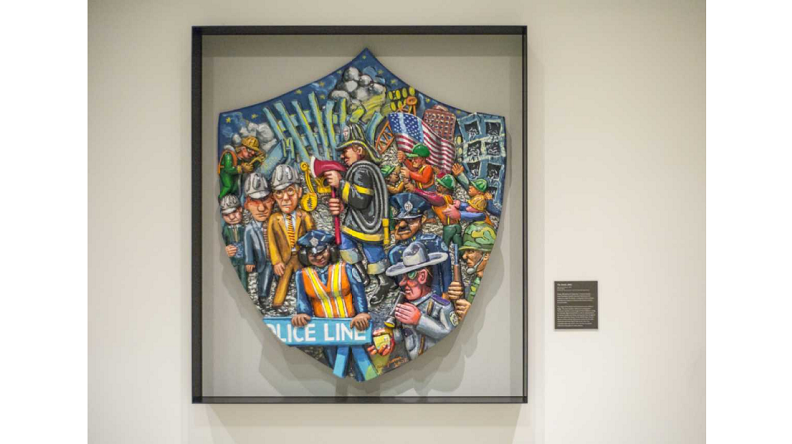
Over the past month, a half-dozen ultra-cleaners from our Collections department have been at work dusting and vacuuming objects on open mounts in the Museum’s quiet galleries, preparing for our public reopening on September 12. Red Grooms’ 2002 artwork The Shield, displayed in the crossroads of the Education Center at bedrock, has been among the recipients of this anticipatory housekeeping.
Less a wall-hung sculptural relief than a three-dimensional comic strip, the piece—at least upon initial encounter—may seem unexpected as a sympathetic response to the 9/11 terror attacks. It is not somber, elegiac, or consoling in purpose. Indeed, its bold colors and jumble of cartoon-like characters appear almost carnivalesque. In other words, it is archetypal Red Groomsian. The Shield’s installation within the commemorative setting of the South Tower footprint invites some clarification.
First, let’s consider its maker, a native of Nashville, Tennessee. Born in 1939, Charles Rogers “Red” Grooms became an elective New Yorker when he first moved north at age 20. After a brief stint at Chicago’s Art Institute, he headed east to Manhattan. Here, he met his consummate future subject as a working artist. After bouncing around various addresses in Chelsea, in 1987 he moved into the America Thread Building on West Broadway, a mile from the World Trade Center. In an oral history later recorded for the 9/11 Memorial Museum, he recalled the clear view of the North Tower from his southerly window, enjoyed in all seasons and weather.
A master of all forms of artmaking, Grooms is best known for his multimedia, pop-inflected interpretations of Gotham’s theatrical street life. In the 1970s, his career rocketed with a succession of immersive walk-in environments which fused fictive and authentically observed urban landmarks and actors. The artist described them as “sculpto-picturesques.” In a previous job, I was delighted and confounded by The Library, a site-specific “walk in” commissioned from Grooms for the Hudson River Museum’s working gift shop. As a curator, my impulses to protect and preserve were undermined by the daily contact of visitors browsing merchandise within Grooms’ kaleidoscope of sensory vinyl surfaces and faux bibliophile patrons. It was hard to police “no touching.” But it was harder not to surrender to the ensemble drama and tactile magic of Grooms’ installation.
Perhaps the most ambitious venture in this vein was the artist’s Ruckus Manhattan (1975), a 10,000-square-foot technicolor wonderwork featuring a condensed, sculptural romp through the cityscape, from Battery Park to Rockefeller Center. (Funding shortfalls curtailed plans for extending the experience as far north as the Cloisters.) Included as place-markers for lower Manhattan were two 30-foot tall surrogates of the Twin Towers, then newly arrived in the skyline. As a further crowd-pleaser, the artist added the figure of tightrope aerialist Philippe Petit. Writing about Ruckus Manhattan in the New York Times, architectural critic Ada Louis Huxtable opined that Grooms’ zany pair of skyscrapers—made from wood and soft vinyl respectively—were preferable to Minuro Yamasaki’s “bland” corporate originals. Eleven years after hijackers toppled those quarter-mile high structures, Superstorm Sandy destroyed Grooms’ more playful Towers when flooding infiltrated their storage space.
Like many who witnessed the events at the World Trade Center in real-time proximity on September 11, the artist was at first confused by what his senses were registering. Around 8:45 a.m. that morning, while sipping tea in the kitchen, he had felt the rumble of a low-flying plane overhead followed by “a screeching, scratchy terrible kind of noise.” Heading to his south-facing window, he saw smoke spewing from the North Tower. As he gaped at the hole punched into the building’s high floors, he was able to distinguish the silhouette of a commercial airliner. Terrorism was his instinctive conclusion. When a second hijacked plane hit into the South Tower, he and his wife evacuated to nearby Tribeca, sheltering in his lower-rise studio space while fearing more attacks, public pandemonium, and the prospect of their hometown becoming immobilized by the decree of martial law. The couple spent the day in high anxiety, hearing and seeing components of the disaster that were ever more inconceivable. In his 2015 oral history, he confessed to feeling “too overwhelmed” to work for months thereafter, enervated and creatively numbed by the stress of daily life inside the Frozen Zone.
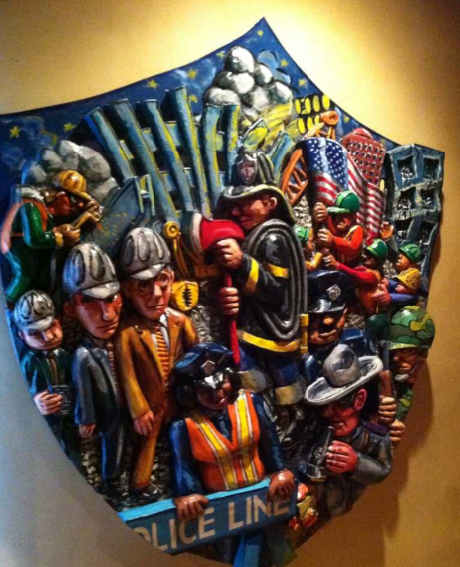
But in 2002, his urban muse reawakened, stirring an idea that materialized as The Shield. Contrary to the predicted impact of 9/11, New Yorkers had not allowed dread to incapacitate their civic life. Cautiously, they repossessed their freedoms, returning to the streets, shops, and subways. They also reclaimed their shared patriotism, sometimes masked by the New York’s diversity, internationalism, and nonchalance. They congregated at the barricades near Groom’s studio to see the ruins at Ground Zero and pay their respects to the victims. In the meantime, a cast of essential workers had their backs, protecting the public, restoring confidence, clearing the wreckage at Ground Zero, and digging to recover and then identify the dead.
Invited to contribute to a traveling exhibition of works on paper responding to the September 11 attacks titled True Colors: Meditations on the American Spirit, Grooms conceived a crowd-scene composed within the symbolic form of a shield. The contemporaneous bas-relief—made from enamel on epoxied cut Styrofoam—is a larger, dynamic, sculpturesque variant of that picture. It was acquired by Museum as a gift from collectors Albert and Margarita Waxman.
When he saw the piece installed in the Museum Education Center’s foyer in 2015, the artist shared memories of its genesis 13 years earlier. The governing form of the shield, he explained, was intended to honor those dedicated to keeping society safe. The symbol held a familial association, as Grooms’ father had worked for the Tennessee State Highway Department.
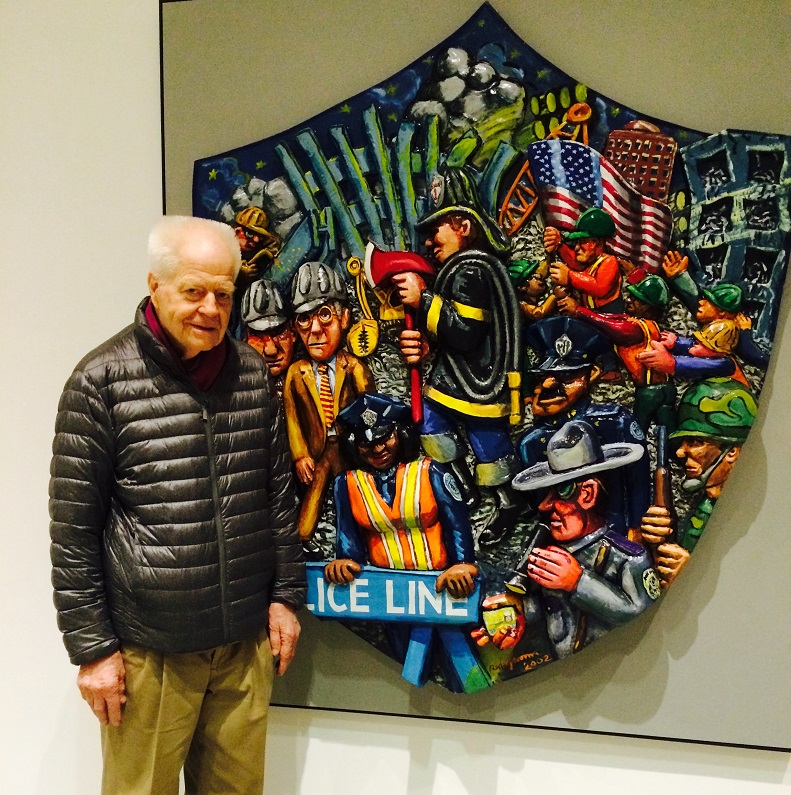
For the Ground Zero backdrop, he purposely incorporated a nod to the defiant vestiges of North Tower steel, still upright after the attacks, along with glimpses of gray rubble, illuminated floodlights, and an orange crane hoist. For the multi-figural primary tableau, he drew on his signature admixture of whimsy and truth. On that human stage, he assembled emergency workers, uniformed responders, and officials typecast from those who had crisscrossed his Tribeca neighborhood in the early weeks after 9/11: law enforcement officers, firefighters clad in bunker gear, National Guardsmen wielding weapons, ironworkers, heavy equipment operators, and besuited and helmeted structural engineers—or politicians, perhaps? The artist further inserted a salute to Tom Franklin’s iconic image of three New York City firefighters attempting to raise an American flag at the ravaged Trade Center on the late afternoon of September 11. However, in this revamping of it, the banner has been hoisted successfully by a crew of hardhats.
Grooms pointed out two authentic portraits. One depicts a “take charge” female police officer he remembered encountering as she patrolled the temporary blockades along Canal Street. He admired the authority with which she “dissuaded” onlookers from crossing into the hazardous terrain further downtown. Also memorialized is a vigilant state trooper or sheriff who was omnipresent at the barriers, armed with a flashlight. It was his duty to check identifications presented by residents like Grooms, requesting access to their homes and workplaces inside the restricted zone.
Grooms’ summary of the artwork was plainspoken. The shield form itself represented the “support” and protection that pulled everything and everyone together despite the trauma of 9/11. The piece demonstrated his respect for all the municipal workers and all others who “kept society going,” unbowed by the staggering challenges then confronting New York City. That indomitable attitude helped to power the city’s recovery and rebound.
Given the compound of fear, heartaches, and disruptions weathered by our nation and world since March, The Shield reminds us of what hope looked like in the hard wake of the September 11 terror attacks. This was Grooms’ tribute to humanity’s unstoppable spirit and collaborative wiring, explaining its seamless fit on the walls of the South Tower footprint today.
By Jan S. Ramirez, Executive Vice President of Collections & Chief Curator, 9/11 Memorial & Museum
Previous Post
Register for This Year’s Anniversary in the Schools Webinar
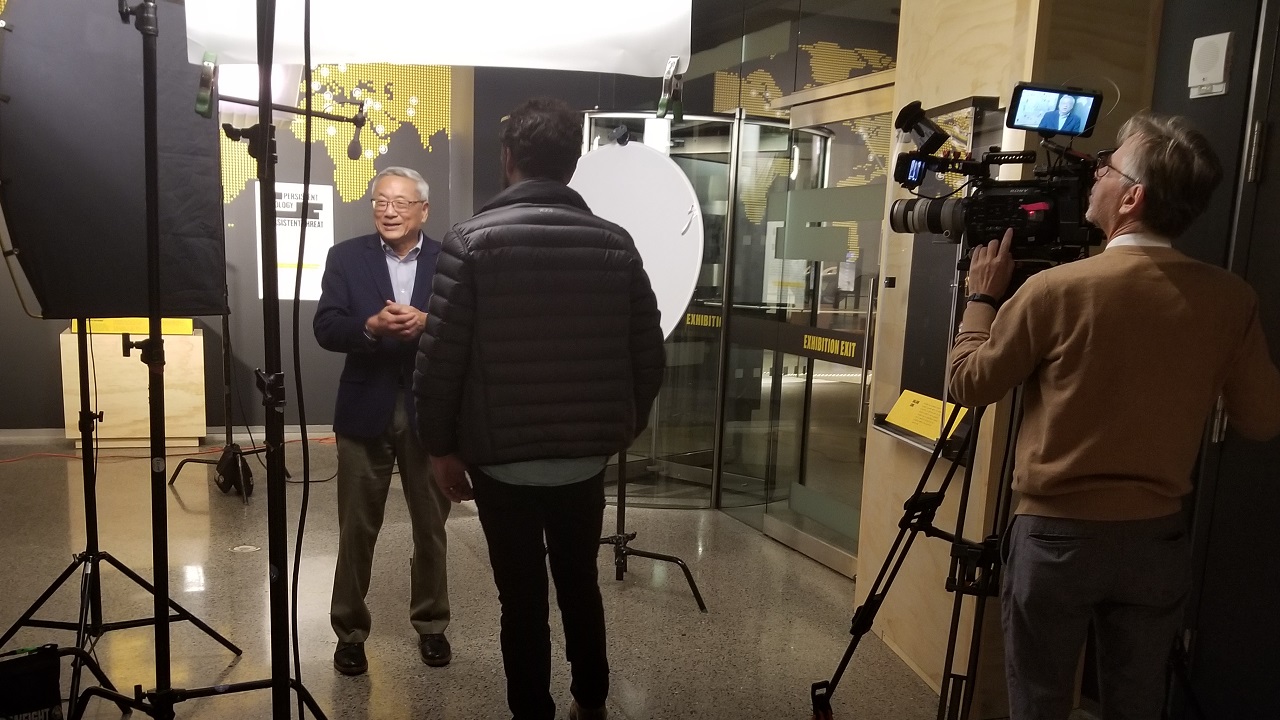
At a time when we are all looking for meaningful ways to connect and educate online, we invite you to join students and teachers from around the world to commemorate the 19th anniversary of 9/11 by registering for the free Anniversary in the Schools webinar on Friday, September 11, 2020.
Next Post
Tickets Available for Museum’s Public Reopening on September 12
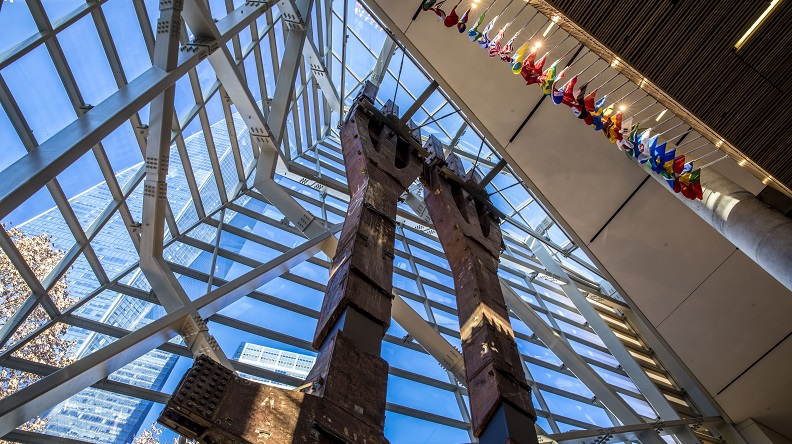
The 9/11 Memorial Museum will reopen exclusively for 9/11 family members on the 19th anniversary of 9/11. It will reopen to the public, five days a week, starting on September 12.